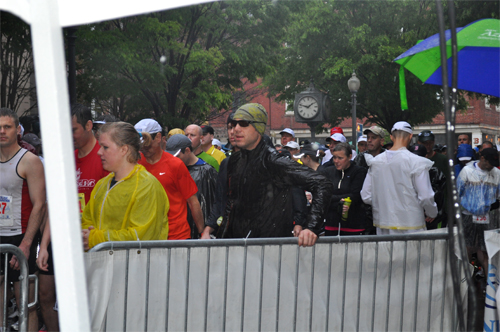My calves are stiff. My body feels weak. As previewed in a recent post, “GJ to Run ‘America’s Toughest Road Marathon,’” I did indeed run the full 26.2 miles — and the 7,234 feet of total elevation change! — of the National College Blue Ridge Marathon, held this past Saturday, April 16, in Roanoke, Va.
It was a tough race, and monsoon-like weather did not help either! But along with a few hundred other dedicated runners I lined up at 7:30a.m. Saturday amid dark skies and cold gusts. Rained poured, literally, from low clouds, and the whole of the race pack was soaked through in seconds.

But spirits were high, and at the “GO!” the runners cheered and lurched off in a stampede to start the long journey through Roanoke and into the big hills beyond.
Now in its second year, the National College Blue Ridge Marathon takes full advantage of the Blue Ridge Parkway and the healthy mountain peaks that ring Roanoke. Since about 2003, I have run one or more road marathons most years. The Roanoke race’s superlative nature — “America’s Toughest Road Marathon!” — enticed me to sign up. Was I ready for the challenge?
I started the race at a fast pace, ticking off the first mile in less than 7 minutes and running with the lead group. But soon the pavement begun to tilt — we were heading up already into the misty mountains over town.

The Blue Ridge Parkway is a gorgeous, meandering road. It climbs through forested gorges, twisting up, and rolling on small passes with 50-mile views. The race course takes long sections of the Parkway and rises to some of its most vertigo-inducing vantages, including the summit of Roanoke Mountain, Mill Mountain, and the city’s iconic “Mill Mountain Star,” a giant sculpture set on a mountaintop that is touted as “the world’s largest freestanding illuminated man-made star.” No doubt!
During the race, the rain never stopped all day. But runners were for the most part happy and some were even reveling in the rain. Spectators huddled under awnings, tarps, and umbrellas, ringing cow bells and shouting out to racers as they tromped by. I ran the initial hills of the course methodically and not too fast, saving energy for the long course ahead.
By mile 7, we’d climbed hundreds and hundreds of feet already, with the aid station at the top of Roanoke Mountain serving as the race’s official “hardest to attain” high point. Indeed, the twisting road up to this point was so steep that all of the racers I saw here walked at least some portions of the ascent.
The race’s big uphills are contrasted by knee-jarring descents. What goes up must come down, and in the Blue Ridge Marathon this means miles and miles of super steep downhill road running. One stretch, near mile marker 8, twisted down unrelentingly, and the rain poured, too. There were slippery bits of moss on the road, too, creating what was likely the most perilous stretch of a “road marathon” I will ever see.
The vertical nature of the course produces wildly varying split times. One mile a runner might take 10 or 12 minutes to pace through a steep climb. Then on the downhill “speeds” might hit the 6-min.-per-mile pace for people (like me) who normally would never run that fast.

In the end, I finished the marathon with a time of 3 hours and 57 minutes. This time put me in 5th place in my age group, “MALE AGE 30 – 34,” and at 37th place overall. My average pace was 9 minutes and 5 seconds per each mile. Not too bad!
I pushed extra hard on the last five miles to break the four-hour barrier, maxing out. I checked my watch and timed each remaining mile. By the end, my legs were mere phantoms, numb and not felt, as I sprinted, finally, across the finish line.
But the pain was worth the reward, and indeed just completing this big, hilly race, regardless of time, felt like a huge accomplishment in itself. If you’ve “been there, done that” on other road marathons around the country, the Blue Ridge Marathon offers a new twist and a challenge unlike any other.
—Stephen Regenold is founder and editor of www.gearjunkie.com. Watch for more on the shoes, apparel, nutrition, and equipment Regenold used on his 26.2-mile “battle in Roanoke.” Updates on the blog soon.






